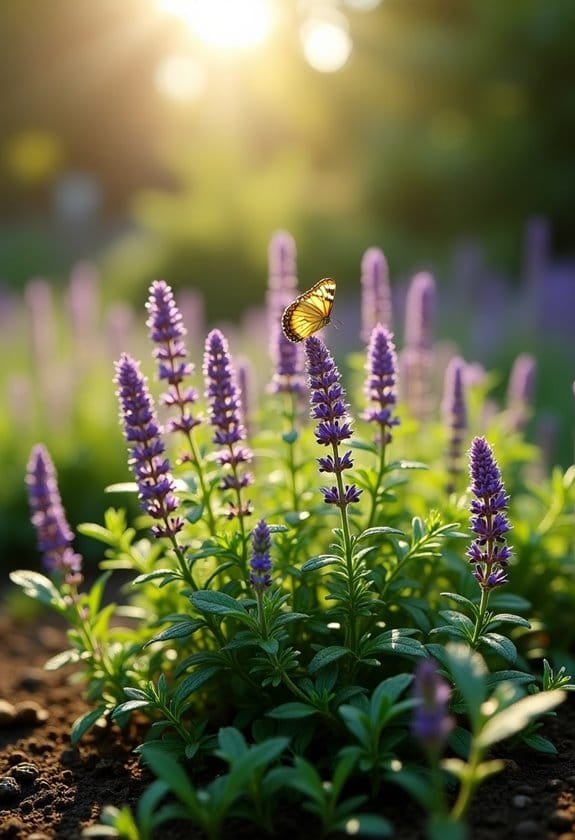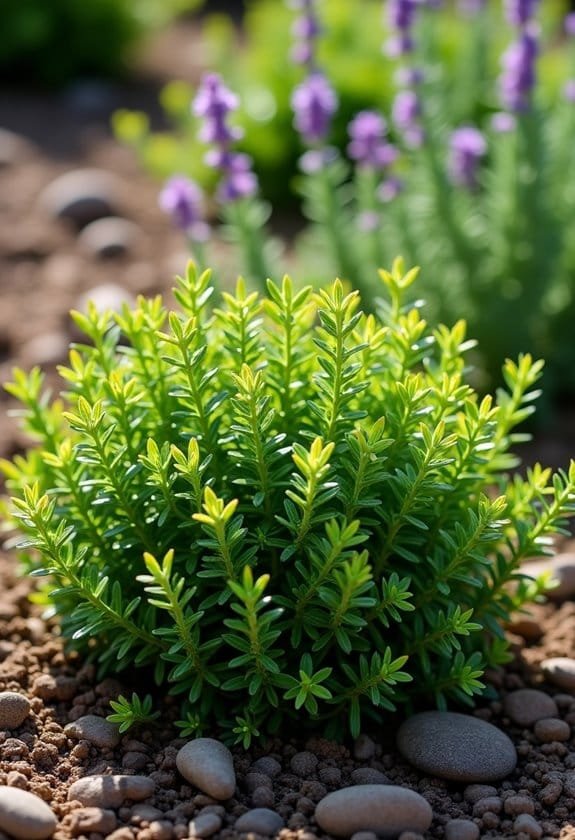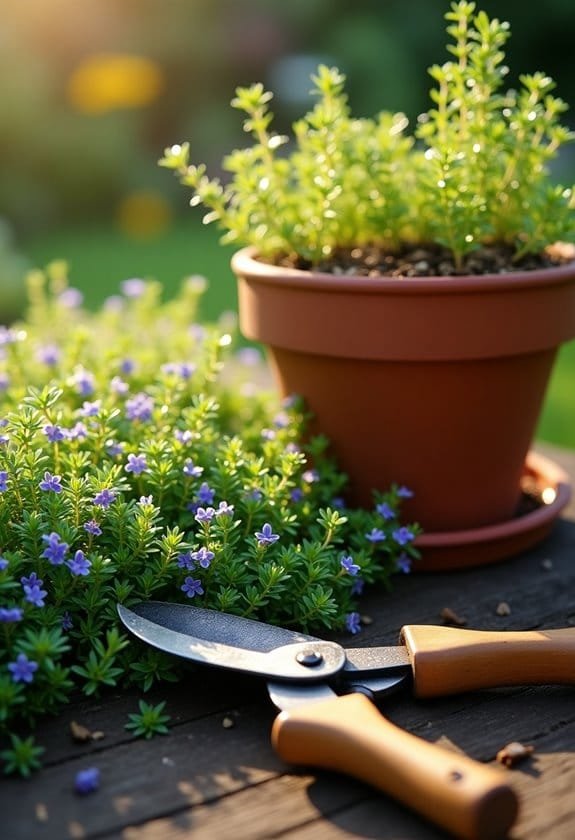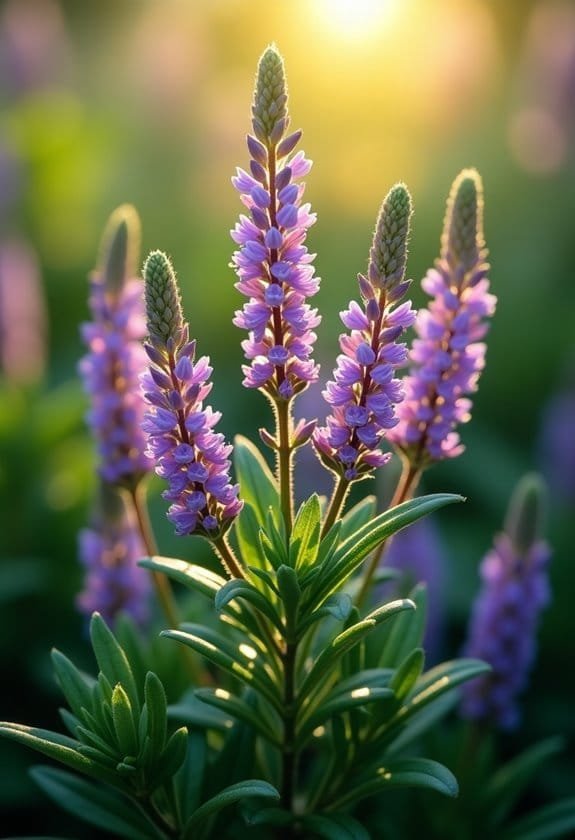Thymus species, known as thyme, includes approximately 350 varieties within the Lamiaceae family, with Thymus vulgaris being the most cultivated. These perennial or evergreen shrubs feature small, aromatic leaves and can grow from 1 to 30 cm tall, forming dense, mat-like structures that expand up to 60 cm wide. Thriving in well-drained, sandy soils, thyme flourishes in full sun, requiring 6 to 8 hours of sunlight daily. This resilient plant attracts pollinators such as bees and butterflies, supporting biodiversity. Given its antiseptic and culinary uses, thyme remains integral to both cooking and gardening. The exploration of its historical significance is equally fascinating.
Main Points
- Thymus includes approximately 350 species, with Thymus vulgaris being the most widely cultivated for culinary and medicinal uses.
- Thyme plants are perennial or evergreen shrubs characterized by fragrant leaves and small, dense structures suitable for ground cover.
- Optimal growth requires full sun, well-drained sandy or rocky soils, and careful watering to avoid root rot.
- Thyme supports biodiversity by providing nectar-rich flowers that attract essential pollinators like bees and butterflies.
- Common thyme-related issues include leggy growth and pests, but it thrives well with drought-tolerant companions such as lavender and rosemary.
Introduction

Thyme, known scientifically as Thymus, encompasses a fascinating array of around 350 species within the Mint family, Lamiaceae.
This hardy plant flourishes in sunny, well-drained soils and boasts an impressive drought tolerance, making it a gardener's delight for both culinary and ornamental purposes.
Common Name
Often associated with culinary delights and fragrant gardens, the common name "Thyme" has deep historical roots. Derived from the Greek words "thumos," meaning courage, and "thymos," meaning perfume, thyme reflects both its aromatic qualities and significant symbolism throughout history.
This versatile herb belongs to the botanical genus "Thymus" within the mint family, Lamiaceae, which encompasses approximately 350 species, illustrating its extensive familial connections.
Since ancient times, thyme has enjoyed a long cultivation history, often being incorporated into Mediterranean cuisine for its robust flavor and aromatic properties. Among the various cultivated species, "Thymus vulgaris," widely known as Common Thyme, stands out, primarily due to its culinary applications, enhancing soups, stews, and roasted dishes alike.
Additionally, thyme's intrinsic association with bravery is remarkable; ancient cultures sewed the herb into soldiers' clothing, hoping to bestow protection and courage during battle. Its cousins like Wild Thyme(Wild Thyme) also share ecological importance by supporting local pollinator populations.
Consequently, thyme transcends mere culinary use, acting as a rich emblem of heritage and resilience, threading together the past and present while enchanting enthusiasts across kitchen and garden alike. Its storied legacy continues to inspire both chefs and herbalists worldwide.
Scientific Name
The scientific classification of thyme plays an essential role in understanding its diverse species and uses. The genus name Thymus categorizes a striking array of approximately 350 species, all nestled within the Lamiaceae family, better known as the mint family. Among these, Thymus vulgaris stands out as the most commonly cultivated variety, often recognized as the quintessential culinary herb, used for its robust flavor in various culinary applications, while also serving ornamental purposes in gardens.
The origins of "Thymus" trace back to Greek, where "thumos" signifies courage and "thymos" denotes perfume, illustrating thyme's historical importance and aromatic appeal.
These herbaceous plants, many of which are perennial or evergreen shrubs, showcase small, fragrant leaves and tubular flowers adorned in shades of white, pink, or purple.
Typically, Thymus species thrive under full sunlight and well-drained, dry or sandy conditions, demonstrating remarkable drought tolerance once established.
Understanding the scientific nomenclature surrounding thyme not only enriches one's appreciation for this versatile plant but also underscores the ecological adaptability that enhances its culinary and ornamental significance.
Overview
With its rich history and significant cultural associations, thyme captivates interest beyond its scientific classification. Belonging to the Thymus genus, thyme encompasses roughly 350 species of perennial herbs and evergreen shrubs within the Lamiaceae family, often recognized for its distinctive aroma and medicinal properties.
Native to areas such as temperate and subtropical Eurasia and Northeast Tropical Africa, thyme is cultivated widely for both ornamental and culinary purposes, gracing gardens and kitchens alike.
This remarkable plant features tiny, fragrant leaves that display a spectrum of colors from verdant green to shimmering silver. In addition to its foliage, thyme produces small, tubular flowers, which may appear in delicate shades of white, pink, or purple, enhancing its ornamental appeal.
Thriving under full sun, the plant exhibits exceptional drought tolerance, preferring well-drained, sandy, or rocky soils once established, making it a resilient addition to any herb garden.
Historically, thyme held profound cultural significance, symbolizing courage in ancient Greece and being lauded for its medicinal applications, particularly its antiseptic properties linked to the key compound thymol.
Thyme continues to inspire admiration and utilization in various domains of human life.
Key Features
Thyme species exhibit a fascinating range of growth sizes, typically varying from low-lying groundcovers, just a few inches tall, to more substantial shrubs that can reach heights of over 12 inches.
Their appearance, characterized by small, aromatic leaves that can display a spectrum of green to silver tones, is complemented by delicate, tubular flowers that bloom in spring and summer, showcasing hues from white to vibrant purple.
This unique combination of size, visual appeal, and flowering season not only enhances garden aesthetics but also provides essential habitats for pollinators, highlighting thyme's ecological significance.
Growth Size
Among thyme species, growth sizes vary considerably, ranging from a low 1–3 cm for some varieties like Thymus serpyllum to taller options such as Thymus vulgaris, which can reach heights of 15–30 cm. This remarkable diversity enables gardeners and chefs to choose thyme plants that best suit their needs and available space.
Many thyme varieties exhibit a densely packed, mat-forming structure, making them ideal as ground cover. For instance, Thymus pseudolanuginosus spreads widely, creating a soft, low carpet of greenery that contributes vibrantly to gardens.
The width of these thyme plants can also differ greatly; some varieties like Thymus praecox Album may expand to an impressive 60 cm, while others, such as Thymus serpyllum Elfin, measure around 1.5 feet across.
These growth sizes are particularly advantageous for those cultivating thyme as culinary herbs, as they lend flexibility in garden planning and culinary applications.
Additionally, thyme's compact stature complements its aromatic leaves and seasonal blooms, enhancing both aesthetics and functional use in diverse planting schemes. The growing conditions necessary for optimal thyme health further highlight its versatility in various landscapes.
Ultimately, the growth size of thyme species plays an important role in their utilization and overall appeal in horticulture.
Appearance
One of the most striking aspects of thyme species is their small, aromatic leaves, which typically showcase a spectrum of colors from gray-green to dark green. These leaves, often linear to ovate in shape, contribute a rich fragrance that enhances culinary dishes, making culinary thyme, particularly Thymus vulgaris, a favorite among chefs. Each leaf isn't only visually appealing but also plays a crucial role in packing flavor and essential oils, especially when harvested just before flowering.
In addition to their remarkable leaves, thyme plants produce tiny, tubular flowers that bloom in clusters during early to mid-summer. These delicate flowers vary in color, ranging from pure white to soft pink and vibrant purple, creating a stunning display that attracts beneficial pollinators.
The bushy growth habit of thyme, which typically reaches 15 to 30 cm (6 to 12 inches) in height, allows these blooms to stand out while creating a lush, aromatic groundcover. Certain species, like Thymus pseudolanuginosus, excel in forming dense mats, thriving in challenging environments and enhancing the aesthetic appeal of gardens and landscapes.
Flowering Season
The enchanting beauty of thyme species comes to life during their flowering season, which typically spans late spring to early summer. This period may vary slightly based on specific species and local climate conditions, yet it consistently showcases thyme's allure.
The flowers, often tubular in shape, bloom in mesmerizing shades of white, pink, or purple, attracting essential pollinators such as bees and butterflies.
Most thyme varieties bloom for an impressive four to six weeks, producing an abundant display of small flowers that markedly enhance their ornamental appeal in gardens.
For instance, Thymus vulgaris, commonly known as common thyme, presents purple flowers, while Thymus praecox features delicate white blooms. These vibrant blossoms not only add beauty but also serve important ecological roles by drawing in pollinators.
Harvesting thyme at a prime moment is essential; the ideal time is just before flowering, as the essential oils concentrated in the leaves are at their peak.
Consequently, this flowering season not only enchants garden enthusiasts but also proves fundamental for culinary applications, emphasizing both function and beauty in the life cycle of thyme species.
Growing Requirements

Thyme requires specific growing conditions to thrive, primarily favoring full sun with 6 to 8 hours of direct sunlight daily.
It flourishes in well-drained soil—ideally sandy or rocky—while being particularly vulnerable to root rot in overly wet environments.
Once well-rooted, thyme exhibits remarkable drought tolerance, needing minimal watering, which makes it an excellent choice for gardens in warmer climates. Additionally, proper air circulation is key to preventing fungal infections, ensuring healthy growth for thyme.
Light
To thrive, thyme plants need full sun exposure, requiring at least 6 to 8 hours of direct sunlight each day. This intense light not only enhances the plants' growth but also enriches their flavor by boosting the concentration of essential oils.
Thyme prefers to bask in the sun, flourishing in environments where it receives ample warmth and brightness. Without sufficient light, thyme can become leggy and weak, necessitating additional pruning for optimal growth.
Planting thyme in well-drained soils, such as dry, sandy, or rocky substrates, further supports its development. Poor drainage can lead to detrimental conditions like root rot, which stifles the plant's growth.
Established thyme plants exhibit remarkable drought tolerance, allowing them to endure dry spells as their root systems mature and adapt. Thus, gardeners should observe that cultivating thyme in sunny locations maximizes both its health and culinary potential.
Soil
In ideal conditions, well-drained soils with a pH range of 6.0 to 8.0 are vital for thyme's success. This herb thrives best in dry, sandy, or rocky soils, which promote peak root growth and nutrient absorption. The plant performs exceptionally well when receiving full sunlight, essential for its robust growth and enhanced flavor profile.
Conversely, excessively moist or heavy soils can lead to disastrous outcomes, such as root rot, making effective drainage critical for thyme's health.
Furthermore, thyme displays remarkable drought tolerance once established, requiring minimal watering beyond its initial growth phase. This resilience emphasizes the need for well-drained soils, which prevent the entrapment of excess moisture.
Although incorporating organic matter can elevate soil quality, thyme generally flourishes in lower fertility environments. Such conditions deter excessive foliage growth, which often detracts from the herb's aromatic flavor.
Consequently, maintaining the right balance in soil composition allows gardeners to cultivate thyme that's not only healthy but also rich in taste. By prioritizing these requirements, gardeners can guarantee a successful and flavorful thyme harvest, enhancing culinary dishes with this cherished herb.
Water
Well-drained soil sets the stage for thyme's thriving growth, but water management is equally important. This herb, known for its remarkable adaptability, prefers well-drained soil and flourishes in dry, sandy, or rocky conditions. Such traits make thyme especially suitable for gardens in water-scarce regions.
Once established, thyme exhibits impressive drought tolerance, requiring considerably less frequent watering compared to other herbs. During the critical establishment phase, however, consistent irrigation is essential for developing a robust root system, particularly in the first few weeks after planting.
It's imperative to achieve a balance; excessive moisture can lead to root rot, thereby thwarting thyme's potential. Hence, growers should avoid watering thyme if the soil remains wet for too long.
For best results, overhead watering should be minimized. Instead, direct moisture at the roots, ideally through a drip irrigation system or by watering at the base of the plant, to guarantee that the delicate roots receive hydration without compromising soil structure.
Cultivating thyme with an understanding of these water requirements enhances its resilience and promotes healthy growth in various climates.
Temperature
Ideal growth for thyme occurs when temperatures are warm, preferably between 60°F to 75°F (15°C to 24°C). Thyme plants flourish in this temperature range, exhibiting vibrant growth and enhanced oil production essential for their culinary and medicinal uses.
Established thyme plants boast drought tolerance, making them perfectly suited for regions with lower rainfall and hotter climates.
Additionally, consistent full sun exposure is fundamental; thyme requires at least 6-8 hours of direct sunlight daily to thrive. This sunlight not only promotes photosynthesis but also supports the plant's resilience to varying environmental conditions.
While thyme can withstand light frost, protecting young plants from extreme cold is essential, especially in USDA zones 5-9.
Furthermore, when it comes to seed germination, maintaining soil temperature around 70°F (21°C) plays a significant role, ensuring ideal conditions for turf establishment.
The interplay of warmth and soil temperature is akin to nurturing a delicate seedling, fostering its progression into a robust plant.
Therefore, understanding the specific thermal requirements of thyme is paramount for successful cultivation, ensuring both flavor intensity and longevity within the garden.
Pollinator Criteria
Thyme plants, especially Thymus vulgaris, attract a variety of pollinators due to their nectar-rich, tubular flowers. These blossoms, characterized by their enchanting hues of white, pink, and purple, not only provide fundamental sustenance for bees and butterflies during the summer months but also facilitate effective pollination. Additionally, thyme's ability to support beneficial pollinators contributes to the stability of garden ecosystems.
Attracted Pollinators
Blooming in late spring to summer, thyme species, especially Thymus vulgaris, draw in a diverse range of pollinators. The nectar-rich, tubular flowers of thyme are particularly attractive to bees, including long-tongued species that find these blooms easily accessible. This adaptability makes thyme a common choice in pollinator gardens, where it serves as an essential food source for these important insects.
As the flowers open during peak foraging periods, they provide a consistent nectar supply, encouraging frequent visits from not just bees, but also butterflies, which are crucial for biodiversity. Furthermore, the aromatic foliage emits volatile compounds that can entice beneficial insects, further enriching the local ecosystem. These characteristics of thyme promote a vibrant habitat, supporting various pollinator populations.
For gardeners aiming to bolster local bee communities, incorporating thyme is an effective strategy. The plant's reliable blooms guarantee a steady influx of nectar during important seasons, empowering pollinators to thrive.
Pollination Method
A plethora of pollinators, including bees and butterflies, are drawn to thyme plants due to their tiny, tubular flowers that are rich in nectar. These delightful blooms typically appear during the summer months, guaranteeing a steady supply of nourishment for various pollinators keen to visit.
Pollinator visitation plays a vital role in the reproduction of thyme, facilitating cross-pollination. This process not only enhances genetic diversity among thyme populations but also bolsters their overall viability.
Thyme flowers vary in color, presenting shades of white, pink, and purple, which serve as visual cues to attract different species of pollinators. The diverse array of colors guarantees that thyme can appeal to a broad spectrum of insects, enhancing its pollination success.
Additionally, by integrating thyme into pollinator gardens, gardeners actively promote a healthy ecosystem, supporting beneficial insect populations.
Care & Maintenance

Thyme thrives best when planted in full sun and well-drained, sandy, or rocky soils, showcasing its resilience as a low-maintenance herb.
Ongoing care includes regular trimming to encourage bushier growth and prevent woodiness, particularly after the flowering phase.
Additionally, pairing thyme with compatible companions like rosemary or oregano can enhance both growth and flavor, creating a vibrant herb garden that supports diverse culinary uses.
Planting Tips
How can gardeners guarantee their thyme thrives? To cultivate this aromatic herb successfully, one must prioritize proper planting conditions. Thyme flourishes in full sun and well-drained, dry, sandy, or rocky soils, making it particularly suited for hot and arid climates. These conditions not only support vigorous growth but also enhance the essential oils needed for culinary applications.
When establishing thyme, gardeners should consider propagation methods such as stem cuttings or dividing rooted sections, as certain species may pose challenges when grown from seed.
To maintain a robust plant, regular maintenance is crucial; trimming leggy growth helps to foster a bushier, more appealing appearance, ensuring healthy growth throughout its lifecycle.
Harvesting thyme leaves just before the plant's flowering phase is encouraged, as this timing yields the richest concentration of essential oils, elevating its culinary and medicinal value.
In addition, shearing back mature thyme every three years is a prudent practice, as it prevents woodiness and stimulates new growth, allowing the plant to remain productive. Furthermore, planting thyme alongside vibrant pollinator plants can enhance beneficial insect activity, contributing positively to garden health.
Ongoing Care
Proper ongoing care is vital for maintaining a healthy thyme plant. Thyme thrives in full sun and well-drained, sandy or rocky soils, making proper drainage essential to prevent root rot. This herb requires minimal watering once established, usually needing hydration only during prolonged dry spells, thereby demonstrating its drought-resistant nature.
Regular trimming encourages bushier growth and prevents the plant from becoming leggy. Ideally, this should be done after flowering or every three to four years to guarantee a robust structure. Additionally, thyme leaves should be harvested just before the plant flowers, as this is when their essential oil concentration reaches its peak flavor profile. Comfrey's deep taproot system, akin to thyme's deep-rooted nature, plays a crucial role in nutrient extraction and soil improvement.
Though thyme exhibits high resistance to pests and diseases, gardeners must remain vigilant for signs of root rot, particularly in overly moist conditions. Confirming adequate plant spacing promotes air circulation, further diminishing the risk of diseases.
Monitoring these factors enables gardeners to enjoy the culinary and aromatic benefits of thyme leaves throughout the growing season. Through dedicated ongoing care, thyme can flourish beautifully, enriching both gardens and kitchens with its delightful properties.
Suggested Companions
Creating a thriving garden often involves selecting the right companions for your plants. Thyme flourishes alongside drought-tolerant companions such as lavender and rosemary. These herbs share similar sunlight and soil drainage requirements, fostering a symbiotic environment that promotes growth.
For an appealing ground cover, thyme can be artistically combined with stonecrops (Sedum) and creeping phlox, resulting in a colorful, low-maintenance display while enhancing soil integrity.
Moreover, pairing thyme with culinary herbs like basil and oregano enriches a diverse herb garden, allowing for easy harvesting and facilitating culinary exploration. This combination not only maximizes the garden's utility but also encourages creativity in the kitchen.
In rock gardens, thyme complements alpine plants like moss phlox (Phlox subulata) and various creeping thyme types, producing a resilient and visually striking landscape.
While tending to thyme, regular trimming and eliminating leggy growth are essential practices, ensuring the plant remains compact and vigorous. This diligent maintenance facilitates ideal growing conditions for companion plants, allowing them to thrive without overshadowing the thyme.
Such thoughtful pairing ultimately crafts a harmonious and fruitful garden ecosystem, bringing both beauty and utility to any outdoor space.
Common Issues
While thyme generally boasts resilience against pests and diseases, it isn't immune to common issues that could threaten its health.
Symptoms such as leggy growth or leaf discoloration often indicate underlying problems, like improper watering or infestations of aphids and spider mites.
Recognizing these issues enables gardeners to implement effective solutions, ensuring their thyme remains lush and vigorous in well-drained soils where it thrives best.
Pests/Diseases
Thyme plants, known for their hardiness, encounter few pests and diseases in well-maintained conditions. While typically resistant to pests, thyme can occasionally face issues with aphids and spider mites. These pests, although present, seldom inflict serious damage on healthy plants, which thrive in ideal conditions.
However, environmental factors, such as excessive moisture, can introduce vulnerabilities, particularly root rot in wet soils or poorly drained areas.
Additionally, thyme is susceptible to certain diseases, particularly fungal infections like downy mildew, which can flourish in overly humid environments. This disease manifests as leaf discoloration and can lead to decline if left unchecked, necessitating vigilance from growers.
Regular inspections for signs of pests or diseases are essential in maintaining healthy plants, as is ensuring proper air circulation around the thyme. Healthy thyme requires minimal chemical treatments, flourishing best when cultivated in dry, well-drained soils that receive ample sunlight.
Consequently, the balance of environmental factors plays an important role in safeguarding these resilient plants from potential threats, allowing for the enduring beauty and flavor that thyme contributes to gardens and culinary creations alike.
Solutions
Maintaining the health of thyme plants involves addressing common issues that may arise despite their hardiness. While these plants are resilient, they can suffer from root rot if planted in excessively wet soils; therefore, ensuring well-drained conditions is imperative. Regularly monitoring soil moisture levels helps prevent such complications, allowing thyme to flourish.
To encourage a compact growth habit and prolong lifespan, pruning should occur after flowering. This timely shearing not only prevents legginess but also enhances the visual appeal of these culinary powerhouses. Additionally, harvesting leaves just before flowering maximizes essential oil content, elevating the flavor potency of this herb in various dishes.
Thyme's drought tolerance permits it to thrive in dry, sandy, or rocky soils with minimal water once established.
To rejuvenate older, woody thyme plants and restore productivity, regular shearing every three years is advisable. This practice fosters new growth and extends the lifespan of these valuable herbs.
Summary

The diverse Thymus genus contains around 350 species, primarily found across Europe, temperate Asia, and northwest Africa. Among these, Thymus vulgaris, commonly known as Common Thyme, and Thymus citriodorus, known as Lemon Thyme, exemplify the aromatic qualities that characterize this evergreen sub-shrub.
Thyme's foliage, rich in essential oils, particularly thymol, lends itself to both culinary and medicinal uses, especially given its recognized antimicrobial properties.
Thriving in full sun and well-drained, dry, or rocky soils, thyme exhibits remarkable drought tolerance once established. This advantageous trait allows it to flourish in diverse gardening contexts, enriching both ornamental and edible landscapes.
Historically, thyme has embodied cultural significance; it symbolized courage in ancient Greece and served medicinal purposes in ancient Egypt, including embalming practices.
Culinary applications of thyme are particularly significant within Mediterranean cuisine, where it infuses soups, stews, and various meat preparations with distinctive flavor. Frequently featured in herb blends like bouquet garni and herbes de Provence, thyme continues to serve as a crucial ingredient, bridging culinary tradition with modern cooking practices.
Consequently, the Thymus genus not only enriches gardens but also enhances culinary experiences across cultures.


